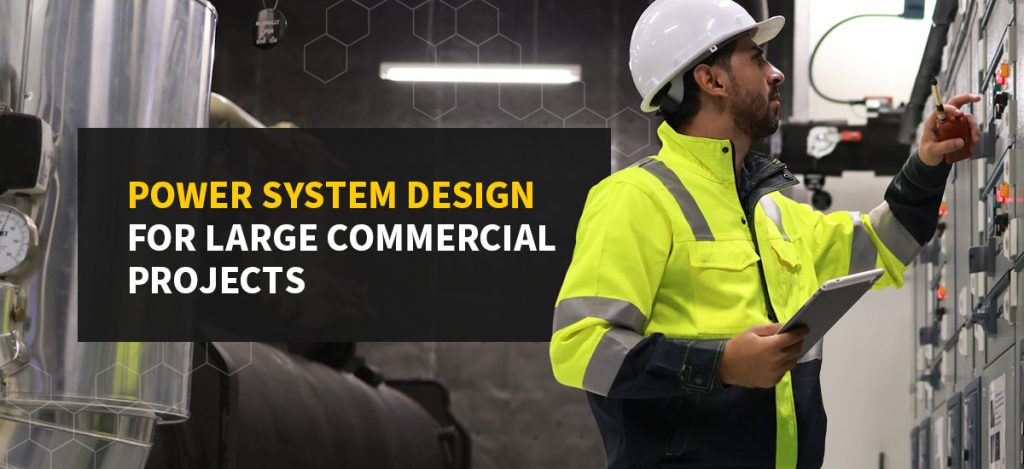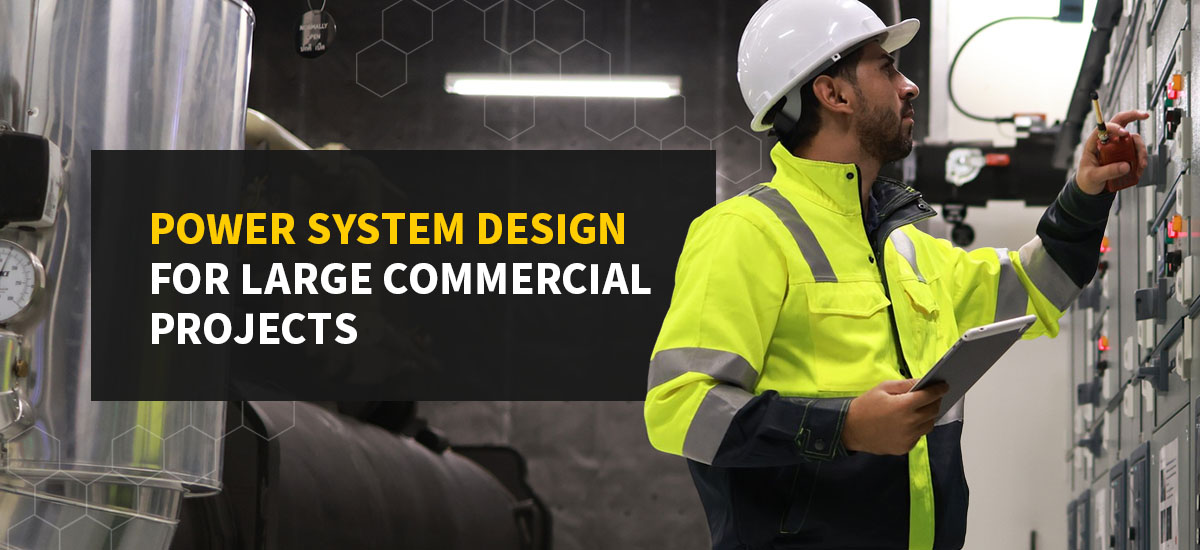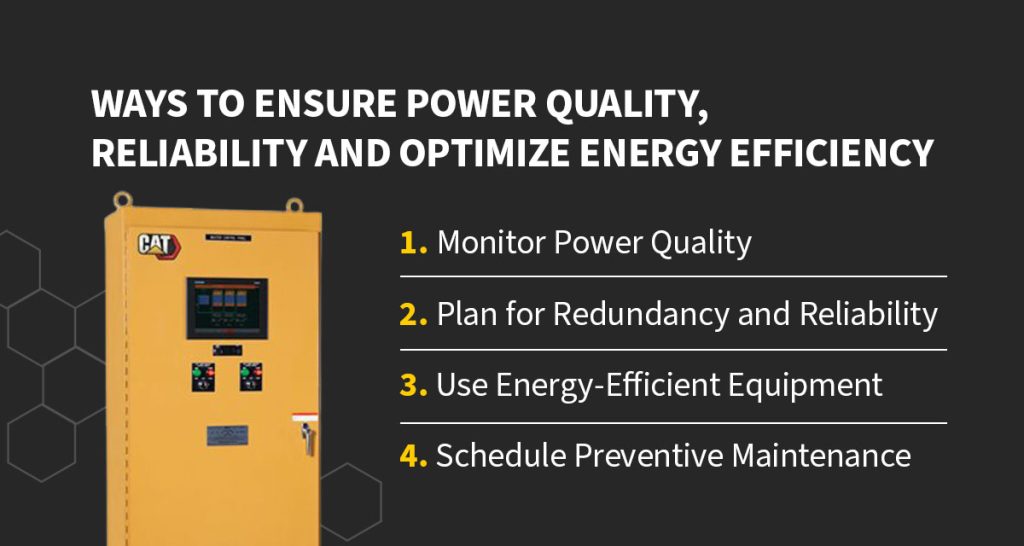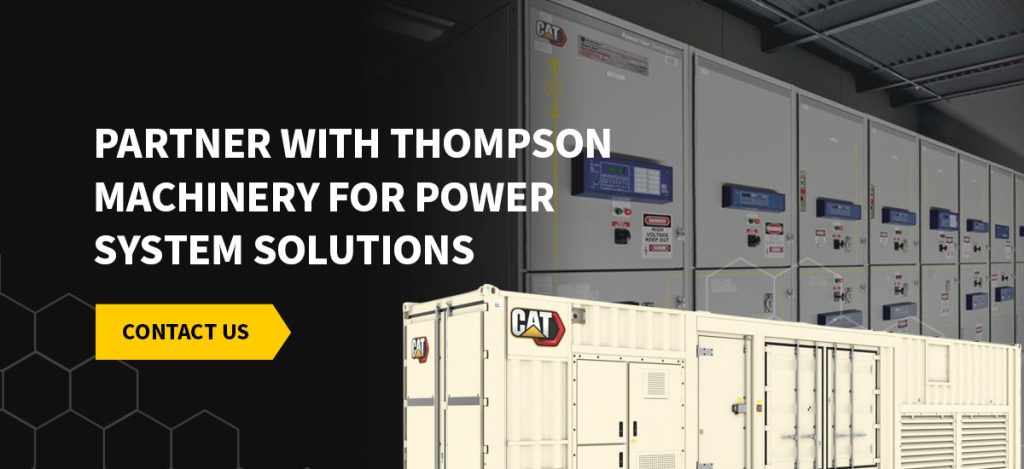
Reliability is crucial when designing a commercial power system. However, teams may experience challenges when scaling power systems, switching between utility and backup sources, or coordinating multiple generators.
Without the right infrastructure, there can be gaps in load management, synchronization issues or delays during transition. Achieving that level of performance requires thoughtful integration of how power is distributed, controlled and maintained.
Learn about the requirements for a commercial power system layout and strategies to ensure energy quality and reliability.
Understanding Project Requirements
Designing a reliable power system entails understanding how a building will function and grow. Explore what to consider when evaluating project requirements.
- Load assessment: Managers and engineers need a clear picture of electrical demands at startup, during peak operation and under different usage scenarios. In your power system design calculations, consider the connected load, usage, operating schedules and equipment behavior during transitions and outages. Simulations via load bank testing can help identify opportunities to optimize capacity. This step also lays the groundwork for backup power planning, demand response integration and long-term operational cost control.
- Code compliance: Life safety systems like emergency lighting, fire alarms and communications must be powered by separate transfer switches or circuits and tested regularly. Circuits must be isolated so faults don’t affect the entire system. Consider local and regional code requirements. Plan review processes vary by jurisdiction, so engaging with inspectors early can minimize costly revisions.
- Future expansion: Designing for expansion may mean leaving space in electrical rooms or specifying switchgear with spare capacity to simplify future integrations. Consider where power needs may shift and include stub-outs or oversized conduit paths to preserve future options and potentially lower retrofit costs.
- Occupancy type and usage: How a building is used affects transformer sizing, generator runtime and uninterruptible power supplies (UPSs) configurations. Understanding daily cycles and peak operational windows allows you to tailor power system design to real-world use.
- Coordination with other trades: The earlier the electrical, mechanical, plumbing and architectural teams work together, the smoother the integration. Shared spaces require clear ownership and coordination. For example, routing a bus duct through a mechanical chase might seem efficient until it clashes with chilled water piping or heating, ventilation and air conditioning (HVAC) ductwork. Coordinating early helps resolve spatial and operational conflicts.
- Budget and timeline: When you understand the loads and space, you can identify where to spend. For instance, investing in higher-efficiency switchgear or gensets can offer long-term savings in energy, maintenance and scalability. Working with a partner that provides configurable systems gives you more control over cost, timeline and specification.
Selecting Your Power Generation Source and Designing the System
Power generation choices impact reliability, performance, cost, space planning and scalability. In large commercial projects, the right configuration balances these variables to support operational priorities and long-term goals. Explore power system design specifications below.
On-Site Generation
On-site generation supplements grid power for peak shaving, resilience or energy independence. Commercial generators provide full standby coverage and support prime power in locations where grid access is limited or unstable.
General commercial building generator requirements call for systems that are:
- Reliably sized for critical and noncritical loads
- Capable of seamless startup and transfer
- Compatible with building management systems (BMS)
- Compliant with local emissions, noise and permitting standards
- Built for durability and easy maintenance
- Fuel flexible
Systems provided by experienced partners offer flexible configurations that align with budget and uptime requirements. They tailor systems to site constraints and load profiles.
Backup Power Solutions
Choosing the right backup system depends on the duration and criticality of outages you expect. For short-term outages, a UPS reconciles grid failure and generator setup, protecting sensitive electronics and data systems. For longer durations, standby generators provide a sustainable source of backup power.
Local codes often dictate which loads must be backed up and how quickly. Working with a provider experienced in commercial generator integration can simplify these choices. They support a wide range of industries with tailored backup solutions that meet reliability standards.
Distribution Lines
Distribution design affects performance, code compliance, and how the system can be expanded or maintained. Decisions include voltage levels, feeder and branch configurations, protective device coordination and selective isolation. Large commercial systems often use low- to medium-voltage feeders for better power quality.
Service entrance location and the layout of the electrical rooms play a role. Switchboards and panels’ strategic position can reduce conduit runs, improve maintenance access and facilitate future upgrades.
Switchgear and Paralleling Controls
Switchgear and paralleling control systems manage electricity and allow for seamless interaction between multiple generator sets, utility sources and facility loads. Solutions support basic standby systems and customized applications.
Some capabilities of these solutions include:
- Multi-unit paralleling: Controllers synchronize and operate up to 16 generator sets, enabling high-reliability systems with built-in redundancy, load sharing and fail-safe operation.
- Load management: Intelligent load add and shed capabilities help optimize performance, conserve fuel and maintain stability across changing load conditions.
- Utility interfacing: Switchgear systems can operate in multiple paralleling modes, providing the control needed to optimize energy costs or support grid resiliency strategies.
- Monitoring and control: Built-in communication protocols and interfaces enable seamless integration with building management systems and a remote monitoring platform to deliver system visibility, diagnostics and control.
- Failsafe load sharing: In the event of communication loss between generator controllers, load sharing can continue via adaptive droop mechanisms to ensure uninterrupted parallel operation.
Integration of Renewable Energy
Some commercial buildings are incorporating renewables for resilience and energy cost management. Solar is the most common, but wind or hybrid systems may be viable. Renewable sources are intermittent, so the system should handle variable output. To maximize grid stability, integrate energy storage systems and controllers.
Energy storage, such as lithium-ion battery systems, can smooth out solar generation or provide ride-through power. Even when not installed immediately, planning for renewables integration can make future additions more seamless.
Ways to Ensure Power Quality, Reliability and Optimize Energy Efficiency
Downtime, inefficiencies and poor power quality translate into higher costs, equipment degradation and disruptions. Here are four ways to ensure electrical stability and energy efficiency.
1. Monitor Power Quality
Power quality monitoring identifies and helps mitigate issues before they cause failures. Advanced monitoring equipment captures data on voltage, frequency, harmonic distortion and waveform anomalies, allowing teams and engineers to pinpoint where instability is occurring. Power quality tools also help verify power conditions after commissioning, track degradation and ensure compliance.
2. Plan for Redundancy and Reliability
Redundancy helps facilities maintain operations during failures, maintenance or load spikes. Reliability planning starts with identifying critical loads and evaluating their acceptable downtime thresholds. For example, in hospitals, power loss for life-safety systems can’t exceed a few seconds. Design strategies include segmented load distribution to isolate failures, automatic transfer switches with bypass capabilities or generator paralleling for load sharing and failover.
3. Use Energy-Efficient Equipment
Look for equipment certified to energy efficiency standards, such as the Department of Energy (DOE) for transformers or Energy Star for end-use appliances. While the upfront cost might be slightly higher, you may experience long-term savings through reduced energy consumption and lower maintenance costs.
In electrical systems, the choice of conductor sizing, transformer loading and harmonics mitigation devices can affect energy losses and thermal stress.
4. Schedule Preventive Maintenance
Power systems need regular upkeep to stay reliable and efficient. Preventive maintenance plans that include testing, inspection and component replacement schedules help extend equipment life and maximize uptime.
Some preventive measures include:
- Insulation resistance testing
- Load bank testing
- Transfer switch inspection
- Battery system checks
- Detailed maintenance records
Remote monitoring tools alert teams to early warning signs. This data-driven approach leads to more predictable operations, fewer failures and reduced emergency repair costs. Some service providers offer ongoing maintenance support as part of their service model, helping streamline upkeep planning.
Partner With Thompson Machinery for Power System Solutions
Thompson Machinery provides power solutions for large commercial projects across Middle Tennessee, West Tennessee and North Mississippi. As the exclusive Cat® dealer in the region, we bring over 75 years of expertise in delivering reliable and scalable systems. We work closely with your team to design and integrate solutions that align with your needs.
We offer on-site generation systems, backup power configurations, transfer switches, switchgear and control systems. To maximize uptime, we also provide preventive maintenance programs and remote monitoring solutions.
Contact us today to learn more.





